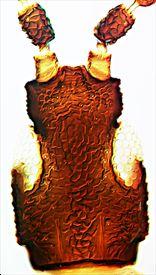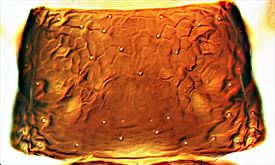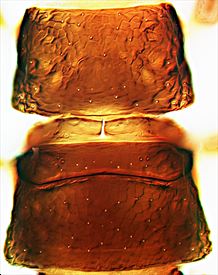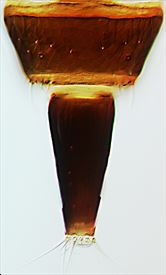Distinguishing features
Both sexes wingless. Body black; antennal segment I and base of segment III, all tarsi, and apex of tube paler. Body surface reticulate, including legs and antennal segment II; head constricted at base, projecting in front of eyes; cheek margins parallel sided; ocelli absent; compound eyes prolonged ventrally; no setae elongate; maxillary stylets wide apart, retracted about halfway into head. Antennae 8-segmented; segment II sharply angled; IV–VI each with a distinct pedicel; VII and VIII closely joined; sense cones reduced, apparently 1 on segment III and 2 on segment IV. Pronotum with no elongate setae; epimeral sutures not developed. Prosternal basantra well developed; mesopresternum not developed. Fore tarsal tooth absent in both sexes. Pelta broad; lateral abdominal setae very short; tergite IX posteromarginal setae less than 30 microns long; tube about twice as long as wide, anal setae short.
Male similar to but smaller than female.
Related species
This genus comprises six black, apterous species from eastern Australia, all of which live in leaf litter or at the base of grasses. It was placed in the subtribe Pygothripina by Mound & Palmer (1983), although it is not closely related to the New Zealand Heptathrips group. This unusual and highly characteristic genus is possibly related to the Australian genus Pelinothrips.
Biological data
Feeding on fungal spores and breeding at the base of montane grasses.
Distribution data
Widely distributed in the South Island, New Zealand (NN, MB, BR, MK, CO), also living in the mountains of southeastern Australia.
Family name
PHLAEOTHRIPIDAE, IDOLOTHRIPINAE
Species name
Emprosthiothrips bogong Mound
Original name and synonyms
Emprosthiothrips bogong Mound, 1969: 185.
References
Mound LA (1974) Spore-feeding Thrips (Phlaeothripidae) from Leaf Litter and Dead Wood in Australia. Australian Journal of Zoology. Supplement 27: 1–106.
Mound LA & Walker AK (1986) Tubulifera (Insecta: Thysanoptera). Fauna of New Zealand 10: 1–140.




